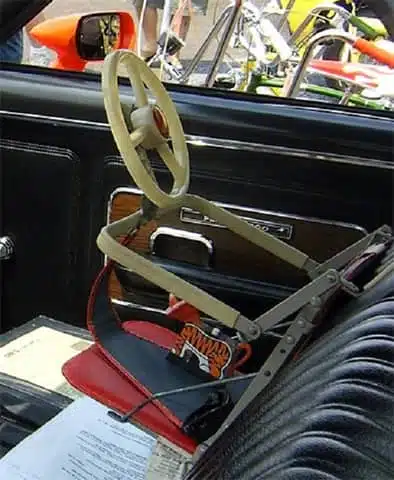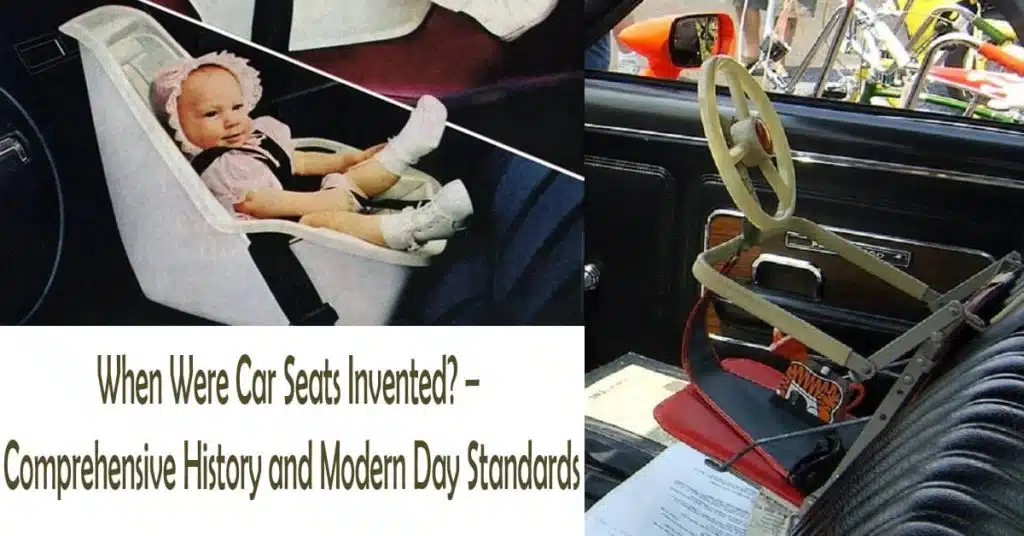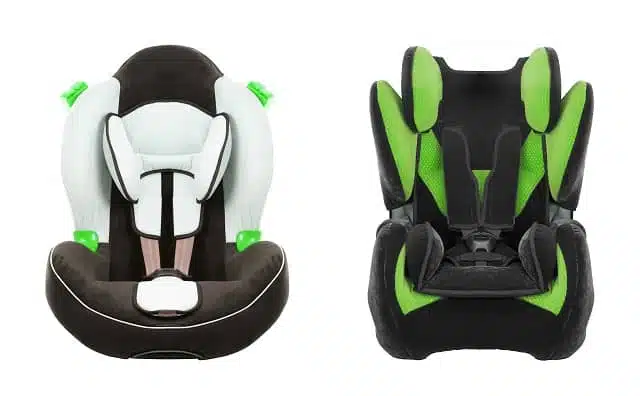Quick Overview of Car Seat History Timeline and Concept
Prior 1933 – car seats were made from burlap sacks with drawstrings attached and hung from passenger’s seats.
1933 – booster seats designed by the Bunny Bear Company – elevate children to be seen from the front
1940 – car seat with a metal frame that could be installed in the front seat – gave the child a better view from the windshield
1962 – car seat with Y-shaped straps that passed over the head and shoulders and fastened between the legs. – the birth of safety
1956 – 1970 – the innovation for safety in the automobile industry set the pace for enhanced safety restraint systems for adult occupants.
When Were Car Seats Invented? – Comprehensive History of Car Seats
The evolution of baby car seats has come a long way from as far back as in the 30s.
It’s incredible how the original intention for a car seat wasn’t about safety but convenience. But as they say, necessity is the mother of invention. To serve the need of keeping a child in place, so came a device to restrain them. And over the 90 years coming, car seats have evolved to what we have today – a child passenger safety restraint device.
In this article, I’ll be covering a comprehensive history of car seats from when they were invented, the several modifications over the years, and the advent of safety laws and regulations.
Car Seats in the 30s – An Idea is Birthed
The Bunny Bear Company would be the pacesetter for the car seat industry when in 1933, they produced the first official car seats, which were basically booster seats made to raise children so parents could monitor them.
However, earlier before that, there were the types designed with burlap sacks with drawstrings attached to hang from the headrest on the passenger’s seat.
Car Seats in the 40s – Innovations for a Better View
Seeing that a child in a car seat could not get a view of the outside while riding, manufacturers came up with innovations for newer designs which were canvas seat bags. They were mounted on a metal frame that could be attached to the front seat to be closer to mom or dad and get a better view of the driving scene through the windshield.
So the child thinks he is like his father driving the car; a dummy steering wheel was attached to the frame which he could steer and think he’s the one controlling the vehicle.

Car Seats in the 60s – Concept for Safety and Legislation
Seeing success with keeping a child restrained and not disturbing a parent, the concern for safety began as children weren’t safe in an accident.
Britain’s Jean Ames designed the first rear-facing car seat in November 1961 – 28years after the first idea was birthed – on the concept that when a vehicle slows down, the occupants are pushed in the opposite direction – forward. This is called the force of inertia in physics.
The idea was that it was safer for the rear-facing occupant to “ride down” in the same direction as the stopping car.
The rear-facing car seat was designed with a Y-shaped strap system to keep the baby firm in the event of an accident which is seen to this day.
Jean Ames was a British journalist who was concerned about her son, Richard Ames’ safety and wanted something that could secure him as much as possible in her car.
The Ames filed for a patent in January 1963 in the United Kingdom for a car seat with a 5-point harness (straps 10- 14) to be molded from glass fiber material, upholstered with padded foam rubber with a harness with which a child could be strapped and secured. The car seats then were bolted to a rigid part of the vehicle by the ends of the straps.
In the same era, there was a newer car seat invention named the Strolee National Safety Car Seat by Leonard Rivkin, a businessman from Denver. This car seat was designed with a metal frame and made use of a 5-point harness, and could be installed in the front or back ‘bench’ seat. At that same time, vehicles were designed with fangled bucket seats which were becoming popular. The car seat could be installed between these seats.
Leonard’s innovation came as a result of an incident where his only child, Bart, who was not restrained, was thrown from the back seat and landed on his wife’s feet in the front seat when a vehicle hit them from behind.
Car Seats in the ’60s – The Revolution / The Modern-Day Game Changer
This period can be termed the game-changer in the safety car seat industry, with the big names coming up with better, safer designs than the existing ones.
This was also the era where safety seat belts were introduced to vehicles as a restraint device for adults. 1956 – 1970 saw the innovation of safety belt which became the means of securing a car seat till this day.
The modernization of car seats originated in Sweden in 1963 when Professor Bertil Aldman of Chalmers University in Gothenburg, Sweden, was watching an American TV program and observed how some astronauts in a Gemini space capsule were secured lying on their backs in the opposite direction of the acceleration force.
What he saw prompted the idea of a car seat that could protect a child in the event of a head-to-head collision, and such a car seat should be rear-facing. He and fellow researcher Thomas Turbell, who is regarded as the father of rear-facing, introduced the rear-facing car seat which became the standard for car seats suited for a child’s safety.
The “T-standard” was set by Sweden safety organizations and recommended children ride rear-facing till at least 4 years of age and has remained so till this day.
In I968, Ford Motor Company gave the blueprint of what we have today, the “Tot-Guard.” It was made from plastic and could be secured with a seat belt, 9 years after the seat belts were introduced to vehicles by Volvo in 1959. This car seat was designed in such a way the front could cushion an impact during an accident.
And then came General Motors in the 70s and 80s with newer and improved car seats like the Loveseat for Toddlers and the rear-facing Loveseat for infants. More General Motors that rocked the 70s and 80s:
Car Seats in the ‘70s
1971:
The Aspen all-purpose Style Car Seat – sold for $19.98
The Crayden High-back Car Seat – sold for $19.98
Gran-Prix – sold for $15.98
The Rover – sold for $13.98
1973:
Infant Love Seat – “baby bucket” car seats
1979:
1979 came with car seats for infants weighing up to 20 lbs. and were rear-facing
The Bobby Mac Car Seat for infants and toddlers – $28.99
The Strolee Wee Care Car Seat – $38.99 and
The Travel Guard Car Seat – $38.99
Car Seats in the ‘80s
1983:
The ’80s saw new car seats that allow for more extended usage, from birth through toddler years (up to 40 lbs.). Simply put, the advent of convertible car seats.
Infants could ride rear-facing in a reclining position, and toddlers, forward-facing in an upright position.
Collier “Safe and Sound” Car Seat – $51.99
Further in the ’60s, when seat belts became a proven safety device for drivers and vehicle occupants, it still experienced pushback from people.
This led to the enactment of laws by Congress for the Department of Transport to set standards for vehicle design – the Twin Highway Acts.
In the 70s, 80s, and 90s
1966-1995 saw the availability of more and more safety equipment such as shoulder harnesses, safety belts, front-seat passenger airbags, and side-impact airbags. During this same period, child safety seats began to grow in varieties (just as you saw above) which came as rear-facing, convertibles, and booster seats and were secured to the vehicle by safety seat belts.
The rear-facing car seats were designed to accommodate infants under 22lbs., convertibles car seats that start as rear-facing for infants and converted to forward-facing for toddlers weighing under 40 lbs. while the booster seats to raise a growing child weighing 30-70 lbs. The weight limits are still seen today in the different types of car seats.
This is still practiced to this day, and then the laws came.
Car Seats Safety Regulations
The first federal safety standards for car seats were established in 1971 and required car seats to be equipped with a 3-point harness system and be secured to the vehicle with a safety seat belt. This was the Federal Motor Vehicle Safety Standard (FMVSS 213) and has been updated over the years to improve standard requirements such as seat back height, buckle release pressure, type of impact-absorbing foam, and much more.
The 1980s – Crash Testing Standard
Since there has now been a safety body responsible for establishing and monitoring safety criteria for car seats, crash testing was introduced to improve the standards.
The crash test standard was set as follows;
- Two vehicles traveling at a speed of 30 mph to a head-on collision;
- a vehicle traveling at 60 mph ramming into a parked car.
Car seats must withstand either of these crash tests and still meet some performance criteria afterward, such as buckle release pressure.
Crash data analysis base of the safety standards for child restraint systems (year 2002, PDF download).
2002 – Focus on Attachment System
After the advent of the seat belt which made installing car seats more secured than ever, a new standard was introduced and became required in new cars produced from September 2002.
The “universal attachment system” is called LATCH (Lower Anchors and Tethers for Children) in the United States, LUAS (Lower Universal Anchorage System) in Canada, and ISOFIX in Europe.
It is an alternative to the seat belt
How Are Car Seats Made
How Products Are Made has a detailed guide on how child safety seats are made. Several high safety standards were set in this modern age when safety regulations came on board for car seat manufacturers compared to the early times.
Each part of a car seat has special safety requirements that must meet strict standards, including pressure, flammability tests, flame resistance, strength, and energy absorption.
Many of these standards for each part makes cleaning baby car seats delicate such as not submerging the straps in water, washing with mild soap, air drying or towel drying, washing method, depending on the part, and more.




Здесь доступен мессенджер-бот “Глаз Бога”, который собрать данные по человеку через открытые базы.
Инструмент работает по фото, обрабатывая публичные материалы в сети. Благодаря ему доступны бесплатный поиск и детальный анализ по фото.
Инструмент актуален на август 2024 и поддерживает аудио-материалы. Сервис сможет узнать данные в открытых базах и предоставит информацию мгновенно.
глаз бога бот
Это сервис — идеальное решение для проверки персон онлайн.
Your comment is awaiting moderation.